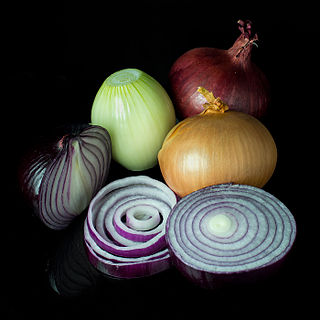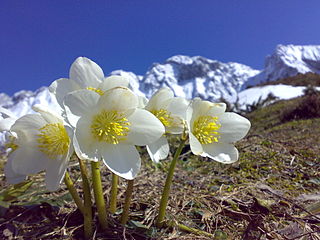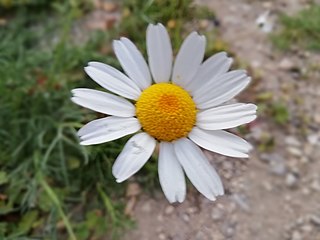
Chives, scientific name Allium schoenoprasum, is a species of flowering plant in the family Amaryllidaceae that produces edible leaves and flowers. Their close relatives include the common onions, garlic, shallot, leek, scallion, and Chinese onion.

An onion, also known as the bulb onion or common onion, is a vegetable that is the most widely cultivated species of the genus Allium. The shallot is a botanical variety of the onion which was classified as a separate species until 2011. Its close relatives include garlic, scallion, leek, and chive.

Lavandula stoechas, the Spanish lavender or topped lavender (U.S.) or French lavender (U.K.), is a species of flowering plant in the family Lamiaceae, occurring natively in several Mediterranean countries, including France, Spain, Portugal, Italy, Turkey and Greece.

Rosa 'Harison's Yellow', also known as R. × harisonii, the Oregon Trail Rose or the Yellow Rose of Texas, is a rose cultivar which originated as a chance hybrid in the early 19th century. It probably is a seedling of Rosa foetida and Rosa pimpinellifolia. The cultivar first bloomed at the suburban villa of George Folliott Harison, attorney, between 8th and 9th Avenues on 32nd Street, north of New York City. The site of Harison's villa is now just south of the present General Post Office. The nurseryman William Prince of Flushing, Long Island took cuttings and marketed the rose in 1830. 'Harison's Yellow' is naturalized at abandoned house sites through the west and is found as a feral rose along the Oregon Trail.

Gypsophila paniculata, the baby's breath, common gypsophila or panicled baby's-breath, is a species of flowering plant in the family Caryophyllaceae, native to central and eastern Europe. It is an herbaceous perennial growing to 1.2 m (4 ft) tall and wide, with mounds of branching stems covered in clouds of tiny white flowers in summer. Another possible source of this name is its scent, which has been described as sour milk, like a baby's “spit-up”. Its natural habitat is on the Steppes in dry, sandy and stony places, often on calcareous soils. Specimens of this plant were first sent to Linnaeus from St. Petersburg by the Swiss-Russian botanist Johann Amman.

Glandora diffusa, the purple gromwell, syn. Lithodora diffusa, Lithospermum diffusa, is a species of flowering plant in the family Boraginaceae. It is a mat-forming perennial growing to 15 cm (6 in) tall by 60 cm (24 in) or more wide, with dark green, hairy evergreen leaves and masses of blue or white 5-lobed flowers. It is suitable for cultivation in a rock garden or alpine garden.

Heptapleurum actinophyllum is a tree in the family Araliaceae. It is native to tropical rainforests and gallery forests in northern and north-eastern Queensland coasts and the Northern Territory of Australia, as well as New Guinea and Java. Common names include Australian umbrella tree, Queensland umbrella tree, octopus tree and amate.

Allium cernuum, known as nodding onion or lady's leek, is a perennial plant in the genus Allium. It grows in open areas in North America.

Phlox subulata the creeping phlox, moss phlox, moss pink or mountain phlox, is a species of flowering plant in the family Polemoniaceae, native to eastern and central USA, and widely cultivated.

Plumbago auriculata, the Cape leadwort, blue plumbago or Cape plumbago, is a species of flowering plant in the family Plumbaginaceae, native to South Africa and Mozambique.

Digitalis grandiflora, the yellow foxglove, big-flowered foxglove, or large yellow foxglove, is a species of flowering plant in the genus Digitalis, family Plantaginaceae. It is native to southern Europe and Asia. In mountains it grows on warm, bushy slopes or areas left after logging. The Latin specific epithet grandiflora means “large flowered”.

Itea virginica, commonly known as Virginia willow or Virginia sweetspire, is a small North American flowering shrub that grows in low-lying woods and wetland margins. Virginia willow is a member of the Iteaceae family, and native to the southeast United States. Itea virginica has small flowers on pendulous racemes.

Festuca glauca, commonly known as blue fescue, is a species of flowering plant in the grass family, Poaceae. It is a commonly cultivated evergreen or semi-evergreen herbaceous perennial.

Helleborus niger, commonly called Christmas rose or black hellebore, is an evergreen perennial flowering plant in the buttercup family, Ranunculaceae. It is poisonous.

Rosa'Veilchenblau' is a mauve hybrid multiflora rose cultivar and the best known violet rambler. Other names are 'Bleu-Violet', 'Blue Rambler', 'Blue Rosalie' and 'Violet Blue'.

Argyranthemum frutescens, known as Paris daisy, marguerite or marguerite daisy, is a perennial plant known for its flowers. It is native to the Canary Islands. Hybrids derived from this species are widely cultivated as ornamental plants in private gardens and public parks in many countries, and have naturalized in Italy and southern California. There are many cultivars, but the most common has white petals.

Rosa 'Old Blush', also known as 'Parsons' Pink China', 'Old Blush China', 'Old China Monthly', is a China rose and has been cultivated in China for over a thousand years. It derives from Rosa chinensis, and is generally accepted as the first East Asian rose cultivar to reach Europe. It is recorded in Sweden in 1752 and in England before 1759, but was probably cultivated in China for several centuries. It is believed to be the rose which inspired the song The Last Rose of Summer by the Irish composer and poet Thomas Moore. It is also known as Parsons' Pink China, named after Mr Parson who introduced it commercially to the UK in 1793.

Allium karataviense is an Asian species of onion in the Amaryllis family. It is commonly known as Turkistan onion or ornamental onion.

Allium is a genus of monocotyledonous flowering plants with hundreds of species, including the cultivated onion, garlic, scallion, shallot, leek, and chives. The generic name Allium is the Latin word for garlic, and the type species for the genus is Allium sativum which means "cultivated garlic".

Rosa 'de Rescht' is a Portland Damask rose introduced by English gardener Nancy Lindsay in 1945. In the first part of her book The Genus Rosa, Ellen Willmott described a rose that is known by the Gilaks as "Gul e Reschti", which is probably the same as Rose de Rescht.





















